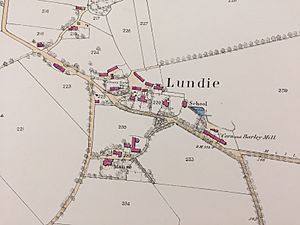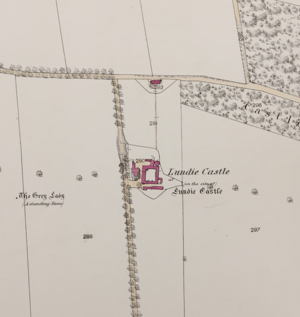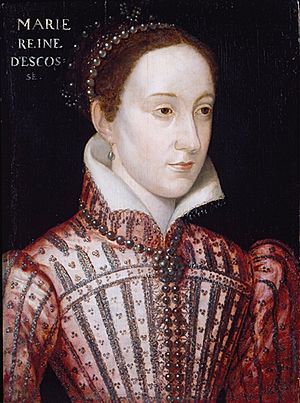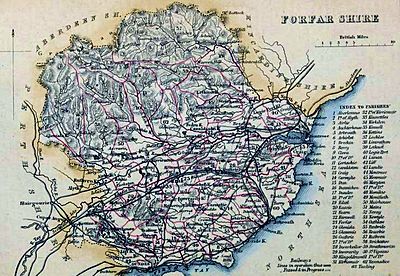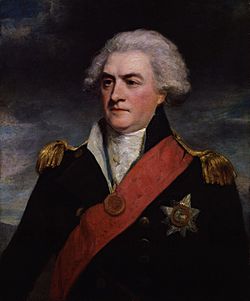Barony of Lundie facts for kids
The Barony of Lundie is a special old title from Scotland. It was created a long time ago, during the time of King David II. This title gave someone the right to be called the Baron of Lundie and own certain lands.
One famous person who held this title was Admiral Adam Duncan. He was a brave leader of the British navy. In 1797, he led his ships to a big victory against the Dutch and French at the Battle of Camperdown. Today, the title and rights of the Barony of Lundie are held by Craig Ward.
Contents
Discovering Lundie Village
Lundie is a small village in Angus, Scotland. It's located in the Sidlaws hills, not far from Dundee in Scotland. The village is surrounded by pretty lochs (lakes) and hills. It's a great place for walks, especially around the Lundie Craigs.
The name 'Lundie' comes from an old Scottish language called Gaelic. It might mean 'black pool' or 'pool of God'.
A Journey Through Lundie's History
The Barony of Lundie is a very old title, going back to the 1300s. It was first created around 1330 to 1370.
Early Barons (1300s-1400s)
During the reign of King David II (1329-1371), a man named John Iles was the Baron of Lundie. Later, around the time of King Robert III (1390-1406), Robert Lyall held the title.
In June 1489, King James IV gave the lands and Barony of Lundie to Andrew, Lord Gray. This happened because Robert, the 2nd Lord Lyall, had lost the title due to political reasons. However, by 1495, the Lyall family got back into the King's good graces. King James IV then gave the Barony back to Robert Lyall, the son of the previous Baron.
The Campbell Family Takes Over (1500s-1600s)
The Lyall family lost the Barony again in 1512. King James IV gave the use of the lands to Grissel Beaton for her lifetime. After her, a part of the Campbell family took over the Barony. They held it for a long time, until the late 1600s.
In 1539, John, Lord Lyall, officially transferred the lands and Barony of Lundie to Sir John Campbell and his wife Isobel Gray. This was confirmed by Mary, Queen of Scots, in 1545. Sir John Campbell was an important person in Scotland's government. He helped rebuild Lundie Castle.
Later, in 1583, Colin Campbell, Earl of Argyll, received the Barony of Lundie from King James VI. This happened after James Campbell of Lundie gave up the title.
King James VI also confirmed a special document in 1614. This document showed that Colin Campbell, Baron of Lundie, had given some lands in the Barony to his wife, Lady Mary Campbell.
Sir Colin Campbell of Lundie was given a special title called a baronet in 1627. This title was passed down through his family, eventually to the Dukes of Argyll.
After Sir Colin died, King Charles I gave the Barony of Lundie to Archibald Campbell, Lord Lorne, in 1634. But Archibald only held it for a short time. The next year, he gave it back to the King, and it was then given to James Campbell, Lord of Kintyre.
During a period of wars in Britain (1638-1651), Campbell of Lundie was a cavalry officer. He fought in battles, including the Battle of Dunbar in 1650. During this time, the lands of Lundie were taken away, but they were returned to the Campbells later when the monarchy was restored.
In 1663, the Barony of Lundie was given to Colin Campbell, the oldest son of George Campbell. When this Colin Campbell died, his son, also named Colin, inherited the title in 1674. After this Colin Campbell, the Barony passed to the Duncan family. The Duncans were important merchants and leaders in Dundee.
William Duncan was a successful merchant in Dundee. His son, Alexander Duncan, also became a merchant and a leader in Dundee. The lands and Barony of Lundie came to Alexander in the 1670s. In 1686, he and his wife Anna Drummond officially received the Barony of Lundie.
Alexander Duncan, Baron of Lundie, died in 1696. His son, also named Alexander, then became the Baron. He was also a merchant in Dundee. This Alexander Duncan was given more lands in 1704 and 1707.
The Duncan Family (1700s-1800s)
During a time of political unrest in Scotland in 1715, Alexander Duncan supported the King. Because of this, he was given important roles in the local government. Alexander Duncan, Baron of Lundie, died in Lundie Castle in 1719.
He had two sons: Alexander, who became the next Baron, and William, who became a doctor to King George II. In 1723, Alexander Duncan became the Baron of Lundie. He was also a merchant and a leader in Dundee. He married Helen Haldane.
Alexander Duncan and Helen Haldane had two sons, Alexander and Adam. The older son, Alexander, became the Baron of Lundie when his father died in 1777. This Alexander was an officer in the British Army. He fought in the American War of Independence. He died in Lundie in 1796.
His brother, Admiral Adam Duncan, then inherited the Lundie estate in 1796. In 1797, Admiral Adam Duncan led the British fleet to victory at the Battle of Camperdown. For his bravery, he was given the titles Baron Duncan of Lundie and Viscount Duncan of Camperdown. Admiral Duncan died in 1804, and his son Robert took over the titles.
Robert Haldane Duncan became Viscount Duncan of Lundie in 1812. In 1831, he was also made the 1st Earl Camperdown of Lundie. He died in 1859, and his son Adam became the next Earl.
Adam Haldane-Duncan was born in 1812. He went to famous schools like Eton and Cambridge. He was a politician and a Member of Parliament. When his father died, he became the 2nd Earl of Camperdown. He also served in the House of Lords. Adam died in 1867, and his son Robert became the next Earl.
Robert Haldane-Duncan (the 3rd Earl Camperdown) was born in 1841. He also went to Eton and Oxford. He followed a political career and held important government positions. He was also honored by the University of St Andrews and was President of University College, Dundee. When he died in 1918, he had no children. So, the lands and titles went to his younger brother George. George Haldane-Duncan was born in 1845 and later moved to America.
Lundie in the 1900s and Today
George became the 4th Earl of Camperdown when he was 73. Since he also had no children, the house and estate passed to a cousin, Georgina. She died in 1937. In 1952, the title of Barony of Lundie and its lands went to Thomas Farrar.
The Current Baron of Lundie
The Barony title and rights passed to Craig Ward in June 2017. He is a solicitor (a type of lawyer) and an author.


